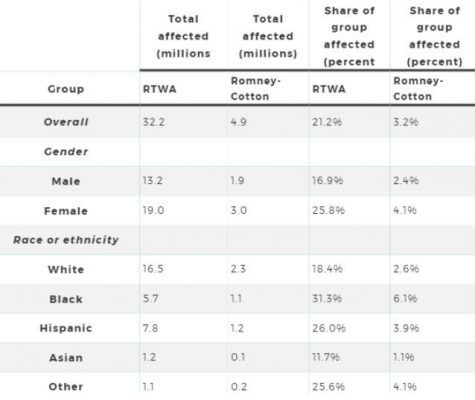Minimum wage debate continues to rage on
Two separate bills have the potential of changing the federal minimum wage from 2021 to 2025, Source: Economic Policy Institute
April 25, 2021
The current federal minimum wage stands at $7.25 per hour and has been that way since 2009. Most states, including Maryland and New York, require employers to pay above the federal minimum wage, but many choose to match the federal minimum.
An increased federal minimum wage has been one of the goals of progressive legislators for many years. Some economists believe a gradual rise of the minimum wage over a set number of years would be beneficial not only for the economy but also for the working class. However, a rise in the minimum wage is not as simple as giving workers more money.
“Wages are one of the main costs for any business,” AP Economics teacher Joseph Clement said. “Any increase in wages makes it harder on a business to produce things and keep people employed.”
Biden proposed a bill that would increase the federal minimum wage to $15 per hour, more than double the current federal minimum wage, as part of the COVID-19 relief bill. However, the proposal did not pass through the Senate because it did not fit the criteria for budget reconciliation, a key factor in the passing of the COVID relief bill. The proposed increase of the federal minimum wage matches that of the Raise the Wage Act of 2021, a separate congressional bill sponsored by Senator Bernie Sanders that aims for a steady increase of the federal minimum wage until it hits $15 by 2025, allowing the economy to gradually adapt to the changes. The bill itself has yet to pass through the Senate and has the potential of never coming back to light.
Additionally, another bill sponsored by Senators Mitt Romney and Tom Cotton was introduced in February. The Higher Wages for American Workers Act of 2021, or more commonly known as the Romney-Cotton Bill, aims for a similar target as the Raise the Wage Act, except its end goal is $10 per hour by 2025 as minimum wage as opposed to $15. The controversy behind the Romney-Cotton bill is the bill’s requirement of businesses to use E-verify, a system that checks the legal status of employees, which has caused a full veto of the bill by the Democrats.

“In the [Northern Virginia area], the minimum wage is slightly higher because we’re the political center of the United States,” sophomore Nidhi Padakanti said. “The raise to $10 [rather than $15] seems more feasible because raising it higher might strain the economy.”
The coronavirus pandemic has also had its effect on the minimum wage. Workers losing jobs and not being able to afford the costs of living after being laid off has caused a fluctuation in money. That fluctuation directly influences the minimum wage.
“Everything is more remote now [because of the pandemic], so the minimum wage is more flexible,” Padakanti said. “There are even people working for companies in different states, which results in a fluctuation of minimum wage.”
A controversy surrounding minimum wage involves the pay of minorities, specifically people of color. According to Vox, people of color, especially women of color, are disproportionately paid just above or at minimum wage and are often the first people to be laid off. Some economists believe that increasing the federal minimum wage would ultimately lead to people of color earning a salary that they can comfortably live off of.
Though Congress has yet to announce or resume a change of the federal minimum wage, people have not stayed silent. Progressives all over social media have voiced their opinions and demanded change be done to let the American worker live comfortably.
“The main argument against raising the minimum wage is if you raise it too high, companies will either have to raise their prices, or they will have to hire fewer people,” Clement said. “Raising [the minimum wage] is aimed at helping the most vulnerable, lowest-wage workers. It’s finding the ‘sweet spot’ of a wage that allows people to meet at least their basic needs while leaving companies enough money to keep all of their employees without having to raise prices too much. That’s the trick…and it’s not easy.”



